“A rose by any other name would still smell as sweet.”
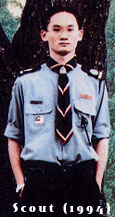
 ith this aphorism better in mind, the V.I. Scouts marched on towards
another decade. No longer were they officially known as the First or
Second Selangor Scout Groups, First or Second Kuala Lumpur Scout Groups,
nor even the First or Second Kuala Lumpur Bandar Scout Groups. In 1988,
the Persekutuan Pengakap Malaysia moved to reorganise the districts
and district names of Kuala Lumpur. Due to the massive increase in the
number of Troops, it was no longer deemed feasible to maintain the old
district structures as this would have meant Troops units numbering
into triple digits. As a result of this reorganisation, the official
district name for Kuala Lumpur Bandar was changed to Bukit Bintang.
Thus the V.I. Troops are officially known as Kumpulan Bukit Bintang
Pertama and Kumpulan Bukit Bintang Kedua. The challenge for this era?
To prove that despite the name change, the V.I. Scouts still maintained
a high degree of excellence in their undertakings. It was not merely
to achieve laurels, but also to ensure that the quality of activities,
training and doing things was not compromised. In other words, to
maintain excellence in ends and means.
ith this aphorism better in mind, the V.I. Scouts marched on towards
another decade. No longer were they officially known as the First or
Second Selangor Scout Groups, First or Second Kuala Lumpur Scout Groups,
nor even the First or Second Kuala Lumpur Bandar Scout Groups. In 1988,
the Persekutuan Pengakap Malaysia moved to reorganise the districts
and district names of Kuala Lumpur. Due to the massive increase in the
number of Troops, it was no longer deemed feasible to maintain the old
district structures as this would have meant Troops units numbering
into triple digits. As a result of this reorganisation, the official
district name for Kuala Lumpur Bandar was changed to Bukit Bintang.
Thus the V.I. Troops are officially known as Kumpulan Bukit Bintang
Pertama and Kumpulan Bukit Bintang Kedua. The challenge for this era?
To prove that despite the name change, the V.I. Scouts still maintained
a high degree of excellence in their undertakings. It was not merely
to achieve laurels, but also to ensure that the quality of activities,
training and doing things was not compromised. In other words, to
maintain excellence in ends and means.
THE V.I. CENTENARY CELEBRATIONS IN 1993
The Centenary year of 1993 is a microcosm of how the V.I. Scouts have lived their Scout promise and law to the utmost, while fulfilling the V.I. goals of ever pursuing excellence in this last decade of the millennium. In 1993, the School’s Centenary year was punctuated with events towards which the ubiquitous Scouts lent their assistance most gracefully. These are often thankless tasks, where efficiency goes unnoticed but mishaps will attract the strongest criticism. Yet, by always remaining true to the eighth Scout Law that ‘A Scout smiles and whistles under all difficulties’, Scouts cultivate perseverance, patience and commitment, perhaps more so than any other uniformed group. And any true Scout should consider himself fully rewarded with the satisfaction of a job well-done. Doing their best - that was what the Scouts set out to do in 1993 (as in other years too), and ensure the Centenary Celebrations were running smoothly. Of course this is not to say that the School did not thank the Scouts at all - it has been casually remarked that in the V.I.C.C. Centenary Tattoo souvenir booklet, the Scouts were listed higher than the Prefects’ Board on the acknowledgement list!
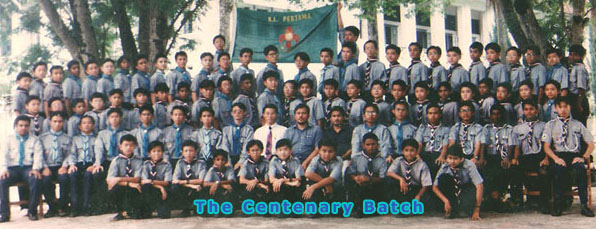
The first major event for 1993 was the
Centenary Cross-Country Run and Launch on January 17. Many Victorians
would remember Mr Robert Sundram and Master Chan Hee Yew descending
onto the field and taking their places in the middle of the
half-circle huddle of hundreds of Victorians. Yet, if one remembers
closely (perhaps with the help of old photographs), accompanying those
two protagonists was a Scout, attired in official uniform, whose role
was to ensure that the balloons released without a hitch. Then on 20
February, Scouts were the ones who set up the parachute tents, lined
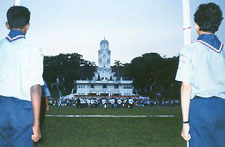 the lane markers for Athletic events, became the runner-boys for
result sheets and served as flag-raisers for the Centenary Sports Day.
In fact, after several years of absence, the two Scout contingents
finally re-appeared in the march past, and they have been a
part of the Sports Day parades without fail ever since. Continuing
this proud link between Scouts and sporting events, when the School
hosted the M.S.S.W.P. Swimming Meet (the state schools’ championship)
on 13 May at the Bandar Tun Razak Swimming Pool, the Boy Scouts were
there to run the result sheets from one official to another, serve
drinks and carry out whatever odd jobs and errands there were. Of
course, in non-sporting events, the Scouts maintained an important
presence too. It was the Scouts, armed with Scout staffs, who
coordinated the flow of people and vehicles during the Tattoo on 10
April and the Centenary Speech Day on 7 August. During the School’s
Open Day Exhibition on Saturday and Sunday 7 and 8 August, the Scouts
also constructed a full-scale campsite, including a monkey bridge, on
the corner of the field near the side-entrance of the School.
the lane markers for Athletic events, became the runner-boys for
result sheets and served as flag-raisers for the Centenary Sports Day.
In fact, after several years of absence, the two Scout contingents
finally re-appeared in the march past, and they have been a
part of the Sports Day parades without fail ever since. Continuing
this proud link between Scouts and sporting events, when the School
hosted the M.S.S.W.P. Swimming Meet (the state schools’ championship)
on 13 May at the Bandar Tun Razak Swimming Pool, the Boy Scouts were
there to run the result sheets from one official to another, serve
drinks and carry out whatever odd jobs and errands there were. Of
course, in non-sporting events, the Scouts maintained an important
presence too. It was the Scouts, armed with Scout staffs, who
coordinated the flow of people and vehicles during the Tattoo on 10
April and the Centenary Speech Day on 7 August. During the School’s
Open Day Exhibition on Saturday and Sunday 7 and 8 August, the Scouts
also constructed a full-scale campsite, including a monkey bridge, on
the corner of the field near the side-entrance of the School.
Besides lending our services to the School events, the Scouts carved several accomplishments to their name, as their gifts to the School on this Centenary year. After a hiatus of almost six years, two V.I. Scouts were honoured to represent Malaysia at an international jamboree. Rizal Kamarulzaman and Darul Kisai, then in Form 2 and both First KL PL’s, left for Bangkok to attend the Thailand Jamboree in November 1993. Around the same time, Second KL was involved in two major activities. In early October 1993, Second KL sent a group of 12 Boy Scouts to the Central Malaysia Jamboree-On-The-Air (JOTA) competition camp at Kem Sardon Jubir, Balakong. There, after three days of competitions like backwoods cooking, campfire performance, catapult construction, obstacle course and drills, they emerged second runner-up. Later, in November, five Second KL Senior Scouts and a Scouter cycled from Kuala Lumpur to Penang. The patron of the expedition was Datin Paduka Saleha bt. Haji Mohd Ali, the Chairperson of the Scout Council of the Federal Territory of Kuala Lumpur, and the sponsors were Tetracon Engineering and Medishield First Aid Supplies. Early on the morning of 4 November, the group consisting of 4 seniors and 2 Scouters was flagged off by Tuan Syed Abu Hassan Mohd Noor, the Deputy V.I. Principal for Student Affairs. At 11.27 a.m. on 7 November, the group arrived at the Penang Scout Headquarters. Indeed, as evinced by this expedition and the other activities, the Scouting spirit was undimmed by the other festivities in the Centenary year.
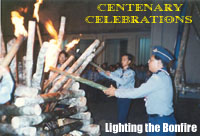
Perhaps the major highlight for the V.I. Scouts during this Centenary year was the combined campfire - the first joint event by both Troops in many years. Most remarkably, this event stands out as one fully organised by the Scouts themselves. In contrast, the other major events of the Centenary calendar such as Sports Day, the Cadet and Band Tattoo as well as the Centenary Countdown, all had the backing - both in terms of human and financial resources - of the Centenary Celebrations Executive Committee and the entire V.I. staff. Undoubtedly (we’re talking about two rival Troops here!), there were organisational difficulties like trying to sort out which Troop would be in charge of which department and other similar matters, but in the spirit of Scouting, these problems were amicably settled. The campfire was held at 7.30 p.m. on Saturday 26 June. The guest of honour for the night was the Assistant State Commissioner, Encik Abdul Kadir Abdul Aziz, who filled in for the absent State Commissioner Mr K.S. Maniam. Encik Kadir, with two Troop Leaders from each of the V.I. Troops, lit the bonfire, marking the commencement of the night’s festivities, which included a human pyramid formation by the Second KL seniors, sketches, a band and games. In the tradition of the V.I. campfires, song books and campfire magazines were published.
The scouting spirit also irresistibly infused the ex-Scouts during this Centenary year. During the Centenary dinner on 14 August at the Shangri-La Hotel Grand Ballroom, Dr Yap Piang Kian organised six tables (at RM1,000 each) for former First KL stalwarts, some of whom flew in from overseas, like Koh Tong Bak and Koh Tong Chui from the USA. At the end of the dinner, the First KL Group Song burst out to shake the rafters of the ballroom. Such enthusiasm was not surprising as these former Scouts had kept in touch all through the years after leaving School. Some of them like Loe Tuck Yen, organise frequent fishing trips to Port Dickson and other places. In this Centenary year, they decided to honour one of their former Scout Masters, Captain John Lever, and his wife Janet, by fully paying for their return air tickets from the USA, their accommodation and seats at the Centenary dinner. Such was their display of respect and gratitude for someone who had given so much to make their Scouting years so enjoyable.
One question that immediately leaps to mind is “How do the V.I. Scouts do so much?” The answer is manyfold, as there is no unique source of success. But underlying that diversity of sources is one common theme - anyone who dares call himself or herself a V.I. Scout must live the ideals of Scouting and the V.I. not just during Scout meetings, but at all times.
PASSING ON KNOWLEDGE - TEACHER ADVISORS AND FORMER MEMBERS
Just as the worldwide movement had accepted females into
their rank, so too did the V.I. Scouts; especially in terms of Scout Mistresses.
Cik Norrizah Jamil (a general teacher for the lower forms) became the
first Scout Mistress of the V.I. Scouts when she was put in charge of
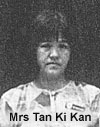 First KL in 1989. The following year, both Troops had Scout Mistresses
in charge. Mrs Tan Ki Kan née Wee Siu Hang, joined Cik Norrizah and
became the Scout Mistress of First KL while Puan Asrima Shariff
assisted Encik Abdul Rahim Wahab at the helm of Second KL. Both Mrs
Tan and Puan Asrima still teach at the V.I. at the time of writing
(2002) - Mrs Tan was a Chemistry teacher but is now in charge of the
school’s Bistari Project, while Puan Asrima is the Head of General
Science. In 1992, Puan Zuraidah Abdullah, a senior Bahasa Melayu
teacher, was enlisted as a Scout Mistress of First KL. It must be
noted that whilst they were called Scout Mistresses, these teachers in
effect merely occupied advisory capacities. The trend of the late
1960’s still continued, where the student Scouters ran the Troops with
almost complete autonomy. Scout skills were imparted from one
generation of students to another without much intervention from the
teacher advisors. Camps were held without the teacher advisors ever
stepping foot on the campsite. Saturday morning activities were
carried out with only the occasional visits by those teachers.
First KL in 1989. The following year, both Troops had Scout Mistresses
in charge. Mrs Tan Ki Kan née Wee Siu Hang, joined Cik Norrizah and
became the Scout Mistress of First KL while Puan Asrima Shariff
assisted Encik Abdul Rahim Wahab at the helm of Second KL. Both Mrs
Tan and Puan Asrima still teach at the V.I. at the time of writing
(2002) - Mrs Tan was a Chemistry teacher but is now in charge of the
school’s Bistari Project, while Puan Asrima is the Head of General
Science. In 1992, Puan Zuraidah Abdullah, a senior Bahasa Melayu
teacher, was enlisted as a Scout Mistress of First KL. It must be
noted that whilst they were called Scout Mistresses, these teachers in
effect merely occupied advisory capacities. The trend of the late
1960’s still continued, where the student Scouters ran the Troops with
almost complete autonomy. Scout skills were imparted from one
generation of students to another without much intervention from the
teacher advisors. Camps were held without the teacher advisors ever
stepping foot on the campsite. Saturday morning activities were
carried out with only the occasional visits by those teachers.
This scenario was dramatically transformed in 1993.
Encik Sharudin Abdul Hadi joined the teaching staff of the V.I. at the
beginning of the year and was put in charge of the First KL Troop. Unlike
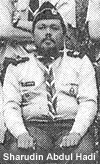 many teacher advisors who had come and gone, Encik Sharudin was also the
Assistant State Commissioner for the Federal Territory of Kuala Lumpur,
and thus, he was effectively given the liberty to manage both Troops.
As the ASC, he made it his mission to be actively involved as a Scout
Master, and not merely play an advisory role. His participation meant
many potential benefits. He would re-acquaint both Scout groups with
many of the recent changes in badge programmes and Scout activities
organised by Persekutuan Pengakap Malaysia (Malaysian Scout Federation).
He was qualified to accredit badges up to the King Scout level. He knew
of the many jamborees that were taking place and could inform the V.I.
Troops about them. Indeed, his joining the Troop signalled a potential
re-integration with the happenings of the Persekutuan Pengakap Malaysia.
many teacher advisors who had come and gone, Encik Sharudin was also the
Assistant State Commissioner for the Federal Territory of Kuala Lumpur,
and thus, he was effectively given the liberty to manage both Troops.
As the ASC, he made it his mission to be actively involved as a Scout
Master, and not merely play an advisory role. His participation meant
many potential benefits. He would re-acquaint both Scout groups with
many of the recent changes in badge programmes and Scout activities
organised by Persekutuan Pengakap Malaysia (Malaysian Scout Federation).
He was qualified to accredit badges up to the King Scout level. He knew
of the many jamborees that were taking place and could inform the V.I.
Troops about them. Indeed, his joining the Troop signalled a potential
re-integration with the happenings of the Persekutuan Pengakap Malaysia.
Re-integration was important because after the retirement
of Mr Robert Tee Sing, the former District Commissioner for Kuala Lumpur
Bandar (the old name of the district for the V.I. Troops), there was no
official from the Persekutuan who updated the V.I. Troops on many of
the goings-on. Mr Tee was a great friend of the V.I. Scouts and was
instrumental in ensuring the V.I. continually produced King Scouts,
took part (and won!) various inter-district competitions and
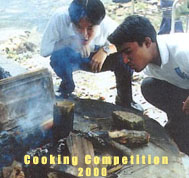 participated in various jamborees. After Mr Tee’s retirement, the
V.I. groups lost the network of information regarding jamborees and
scout camps, and also the V.I. Scouts developed their own programmes
and test standards from the Tenderfoot up to the First Class level.
In short, the isolation forced the V.I. Scouts to become self-sufficient
and independent particularly for badge tests and Scout activities. The
V.I. Troops developed their own test programmes. This they did when the
Persekutuan revamped their test standards in the early 1980's. Feeling that
the new programme had significantly eased the challenge and rigour of old
tests, the V.I. Troops, particularly Second KL, decided to maintain the old
tests. The Scouters, Ex-Scouters and Courts of Honour spent much effort
collating, typing, illustrating and publishing the manuals containing the
more onerous test requirements. For example, there are only six tests in
the Persekutuan’s Tenderfoot syllabus, while there were double the number
in Second KL’s syllabus. In terms of Scouting activities, the competence
demanded of the V.I. Troops also greatly exceeded that required by the
Persekutuan. For instance, the standard of the V.I. Troops’ obstacle course
programmes (from which the Form 1’s had no exemption) would only be expected
of a Lencana Maju (the Persekutuan’s First Class) Scout. Indeed, such high
standards have been the reason that even though V.I. Scouts were not King
Scouts, whenever they travelled to compete against Troops with King Scouts,
the V.I. Scouts would have no difficulty winning.
participated in various jamborees. After Mr Tee’s retirement, the
V.I. groups lost the network of information regarding jamborees and
scout camps, and also the V.I. Scouts developed their own programmes
and test standards from the Tenderfoot up to the First Class level.
In short, the isolation forced the V.I. Scouts to become self-sufficient
and independent particularly for badge tests and Scout activities. The
V.I. Troops developed their own test programmes. This they did when the
Persekutuan revamped their test standards in the early 1980's. Feeling that
the new programme had significantly eased the challenge and rigour of old
tests, the V.I. Troops, particularly Second KL, decided to maintain the old
tests. The Scouters, Ex-Scouters and Courts of Honour spent much effort
collating, typing, illustrating and publishing the manuals containing the
more onerous test requirements. For example, there are only six tests in
the Persekutuan’s Tenderfoot syllabus, while there were double the number
in Second KL’s syllabus. In terms of Scouting activities, the competence
demanded of the V.I. Troops also greatly exceeded that required by the
Persekutuan. For instance, the standard of the V.I. Troops’ obstacle course
programmes (from which the Form 1’s had no exemption) would only be expected
of a Lencana Maju (the Persekutuan’s First Class) Scout. Indeed, such high
standards have been the reason that even though V.I. Scouts were not King
Scouts, whenever they travelled to compete against Troops with King Scouts,
the V.I. Scouts would have no difficulty winning.

The effects of Encik Sharudin’s joining were seen almost immediately. As mentioned previously, in 1993, two First KL Scouts took part in the Thailand Jamboree while the Second KL contingent emerged as runner-up in the Central Malaysia Jamboree Competition Camp. However, there were also irreconcilable differences in terms of badge programmes and Scouting activities. Encik Sharudin’s reaction was that ‘they asked too much of the boys’. He banned the test standards of the V.I. Troops and forced the Form 1’s to take the Tenderfoot tests directly from him rather than the members of the Courts of Honour (the Boy Scout and Senior Patrol Leaders and the Scouters) as had been the tradition. He insisted that Saturday meetings become fully devoted to test-taking activities. This was a dramatic change from the past, where Saturday meetings were devoted to Scouting activities that were not necessarily test-related, and test-taking was set for outside meeting times at the initiative of the test-taker. Whilst the Form 1’s were more dominable, Encik Sharudin could not change the mindsets of the Scouts of the other Forms, and thus the ‘non-Persekutuan’ ways still continued in the Troop.
At the end of 1998, Encik Sharudin left the V.I. and
thus, the V.I. Scout movement as well. He was replaced in First KL by
Encik Kamal Ariffin and in Second KL by Miss Shanti Purushothman. The
appointment of Miss Shanti has an interesting story behind it. She
joined the V.I. at the beginning of 1998 as a teacher of English,
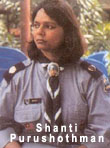 and taught several Form 5 classes. The Fifth Formers of Second KL discovered
that she was formerly a Woodbadger (albeit for the Cub Scouts), and
with the imminent departure of Encik Sharudin, decided that she would
be the most desirable replacement. Hence, the Principal Puan Salha
Othman and the Vice-Principal Puan Jamaliah Rahmat were approached
with the request for Miss Shanti to be Scout Mistress, and when Miss
Shanti agreed, Puan Salha approved the request. Thus, from the
turbulent relationship the Scouts had with Encik Sharudin, this was a
complete turnaround, as the Scouts initiated the first move to
establish good ties and cooperate with the SM. And unlike the teacher
advisors for the previous three decades, Miss Shanti has attended
every single Second KL camp and most activities of the Troop, and her
presence has always been welcome by both the Scouts and the parents.
In 2001, a special plaque of appreciation was presented to her by the
parents of the Second KL Scouts during the Annual Parents’ Campfire.
and taught several Form 5 classes. The Fifth Formers of Second KL discovered
that she was formerly a Woodbadger (albeit for the Cub Scouts), and
with the imminent departure of Encik Sharudin, decided that she would
be the most desirable replacement. Hence, the Principal Puan Salha
Othman and the Vice-Principal Puan Jamaliah Rahmat were approached
with the request for Miss Shanti to be Scout Mistress, and when Miss
Shanti agreed, Puan Salha approved the request. Thus, from the
turbulent relationship the Scouts had with Encik Sharudin, this was a
complete turnaround, as the Scouts initiated the first move to
establish good ties and cooperate with the SM. And unlike the teacher
advisors for the previous three decades, Miss Shanti has attended
every single Second KL camp and most activities of the Troop, and her
presence has always been welcome by both the Scouts and the parents.
In 2001, a special plaque of appreciation was presented to her by the
parents of the Second KL Scouts during the Annual Parents’ Campfire.
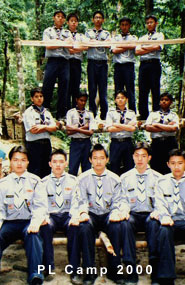
As the teacher advisors (except Encik Sharudin and Miss Shanti) since the late 1960’s had been maintaining mere advisory roles, there was a niche for ‘experts’ who could teach and motivate the V.I. Scouts in scouting. This was far cry from previous years when the V.I. Scout Masters and ASM’s were either teachers or students who were qualified as Assistant District Commissioners, District Scout Masters, Woodbadgers, King Scouts or Bushman’s Thong holders. To make up for the shortcoming, the Senior Scouts and the Scouters of the V.I. Troops ensured that they honed their skills to very high levels, and with those skills, the Seniors and Scouters taught their juniors. For instance, the Seniors and Scouters would organise Second Class or First Class courses. As well, anyone wishing to take badge tests would take them from the Seniors and Scouters. This moulded the independence and maturity of the V.I. Scouts. In addition to this, former Scouts also returned to share their experience and knowledge. Indeed, logically, the cumulative knowledge of former Scouts (or Ex’s) easily exceeds the knowledge shared among the existing Seniors and Scouters of the Troop. And this importance has not gone unnoticed by the V.I. Troops, who always welcome their Ex’s. For instance, the 2001 Annual Parents’ Campfire of Second KL saw a turnout of around 100 Ex’s, ranging from those who had left in the 1950’s to those who had only been in the Troop in 2000. It also helps that ex-Scouts are promoted to important positions in the Persekutuan, such as the former First KL member Kelvin Wong, who, in the 1990’s, held the position of Assistant District Commissioner for Bukit Bintang.
MAINTAINING SCOUTING SKILLS
As in the previous epoch, there have been weekly Troop meetings on Wednesdays/ Thursdays and Saturdays. Scouts also went for patrol duty, Court of Honour meetings, Scoutcraft training and badgework. However, beginning from the mid 1990’s, several traditions were ‘downgraded’. Swimming sessions during Saturday meetings ceased when the Troops failed to produce holders of the Bronze Medallion. Bukit Takun, a favourite hiking destination, was no longer accessible due to the development of a Golf Course in Templer’s Park. The last batch of Seniors to scale Takun were the Second KL Seniors of 1991. More importantly, the tradition of badgework was changed dramatically when ASC Encik Sharudin became a V.I. Scout Master. The last cohort of Second KL Scouts to undertake the Group’s self-developed tests for badges other than the Tenderfoot, was the Fifth Form class of 1995.
For camps, the Get-To-Know-You Camp has been the most
long-lasting and invariable. They have been almost always held sometime between
January and early March every year for each Group. Meanwhile, beneficial though
the Competition Camps were, these have unfortunately been rather irregular in
the 1990’s. Second KL held theirs in 1988, 1989, 1990, 1991 and 1994 while
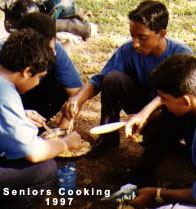 First KL had theirs in 1990 and 1992. The danger of not resurrecting this
event is that Scouting efficiency, so well-developed during that five-day
Camp as precedents have unquestionably shown, would deteriorate. As for
Training Camps or PL Camps (PL Camps were mainly a First KL event), these
have been held at least once almost every year.
First KL had theirs in 1990 and 1992. The danger of not resurrecting this
event is that Scouting efficiency, so well-developed during that five-day
Camp as precedents have unquestionably shown, would deteriorate. As for
Training Camps or PL Camps (PL Camps were mainly a First KL event), these
have been held at least once almost every year.
Enjoyment of the outdoors was still a prominent trait of the V.I. Scouts, as exemplified in the continuation of events like the Treasure Hunts and Pleasure Trips. The First KL Hunts were held in 1988, 1989, 1991, 1995 and 2000. The irregularity of these Treasure Hunts for First KL was compensated by other major activities like Night Games (which involved Scout games and Mini Treasure Hunts) and Senior Scavenger Hunts. Unlike the Annual Treasure Hunts, these activities were held around the school compound. Meanwhile, apart from a temporary absence in 1988 and 1989, the Second KL Hunts have been organised annually without fail on nights between March and June from 1990 to 2001. Second KL also organised Pleasure Trips during the year-end holidays. The Second KL Pleasure Trips were to Pangkor Island, Penang and Cameron Highlands (1988), Langkawi, Penang and Cameron Highlands (1990), Desaru and Singapore (1991), Penang (1996), Pangkor Island (1999), Penang (2000) and Langkawi (2001). First KL had a Pleasure Trip in 1988 to Pangkor Island, Penang and Cameron Highlands.
The Campfire, an opportunity to showcase their talents - organising audio and lighting, seeking sponsorship, constructing elaborate gadget sites, performing, preparing refreshments - was another grand event. (See A History of the Second KL Parents' Campfire.) For First KL, their Annual Campfires were held in 1991 to 1994, 1997 and 1999 to 2001. The Second KL Parents’ Campfires, which marked the end of the Scouting year for the existing administrative cohort, were held every year except in 1990 and 1994. Another major event, but less frequently organised, was the Gang Show. After 24 years, the First KL finally organised a Gang Show on 19 February 2000 at the Selangor Club Ballroom. The Show, displayed the talents of the Scouts in a variety of innovative song, dance and sketch performances. It was organised with the help of Mr Yee Peng Kee (ASM 1980, 1981).
BLAZING THE ADVENTURE TRAIL
The charge towards greater heights was analogous to the many major expeditions organised by the V.I. Scouts. Unlike the smaller scale scout hikes or ‘journeys’, these expeditions involve traversing massive expanses of land, often fraught with arduous challenges be it in terms of the weather or terrain. Expeditions are beneficial in many ways. For example, they could move at maximum speed possible, trying to set new records, while pushing their physical capabilities to the limit. Or as they hike along their trail at reasonable pace, the group can note the change in weather and terrain or identify the different flora and fauna they come across. They could also test the most efficient way for taking each step or rolling each bicycle pedal, to find out what method minimises effort or generates most power in movement. In possessing such knowledge of nature or principles of energy conservation, one becomes a better Scout.
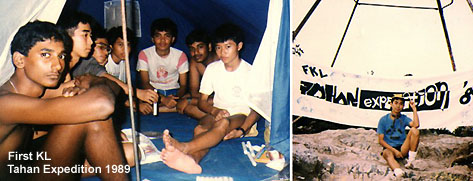
In 1988, Second KL organised an expedition to conquer Gunung Kinabalu between 21 to 23 November. Their preparations received the assistance of the then Dato’ Bandar of Kuala Lumpur, Dato’ Elyas Omar (now a Tan Sri), whose son Dzamir Elyas was a Second KL member. Latching onto the Kinabalu motivation, another group of Second KL Scouters and ex-Seniors, numbering 12 in total, braved rough terrain and unpredictable weather for about a week in March in the heartland of Taman Negara, Pahang. Their goal of Gunung Tahan was deservingly conquered, though not without its moments of anxiety. One expedition member received about 15 hornet stings when his friend accidentally upset a nest that was hidden in the bushes. On another occasion, a snake slithered under one the expedition member’s legs. The First KL Scouts were not to be left behind in this pursuit of such macho adventure when they too organised an expedition to Gunung Tahan in 1989.
In 1993, the two Second KL Scouters and four seniors
cycled to Penang in
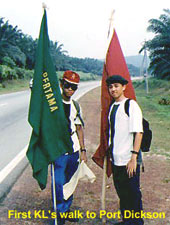 November, as has already been noted. In 1994, after a hiatus of five
years, Gunung Tahan was again conquered on 12 June. It was long overdue
as it was hitherto (in the 1980’s) a biennial activity for Second KL.
This time, seven Senior scouts and one Scouter from the group achieved
that feat, making an eight day expedition from 8 June to 15 June. The
initiative of this expedition was partly attributable to a former Second
KL Senior Scout Leader, Sekhar Sathyamoorthy, who was leading a group
of students from University of Malaya for the trip. He mooted the idea
to the Scouts, and even agreed liaise with the Taman Negara authorities
on behalf of the Troop. Such is another example of the importance of
maintaining links with former members, an advantage that puts the V.I.
Troops in good stead over other Troops. The other conquest by the V.I.
Scouts in August that same year was that of Port Dickson by First KL.
Starting from Nilai on 22 August, 63 Boy Scouts, 21 Senior Scouts and
5 Scouters walked over 40 kilometres within 24 hours to reach their
destination. Indeed, it would have been a Herculean effort for those
physically unprepared; yet in that expedition group of First KL were
many First Formers who completed the challenge.
November, as has already been noted. In 1994, after a hiatus of five
years, Gunung Tahan was again conquered on 12 June. It was long overdue
as it was hitherto (in the 1980’s) a biennial activity for Second KL.
This time, seven Senior scouts and one Scouter from the group achieved
that feat, making an eight day expedition from 8 June to 15 June. The
initiative of this expedition was partly attributable to a former Second
KL Senior Scout Leader, Sekhar Sathyamoorthy, who was leading a group
of students from University of Malaya for the trip. He mooted the idea
to the Scouts, and even agreed liaise with the Taman Negara authorities
on behalf of the Troop. Such is another example of the importance of
maintaining links with former members, an advantage that puts the V.I.
Troops in good stead over other Troops. The other conquest by the V.I.
Scouts in August that same year was that of Port Dickson by First KL.
Starting from Nilai on 22 August, 63 Boy Scouts, 21 Senior Scouts and
5 Scouters walked over 40 kilometres within 24 hours to reach their
destination. Indeed, it would have been a Herculean effort for those
physically unprepared; yet in that expedition group of First KL were
many First Formers who completed the challenge.
The next expedition triumph again belonged to First KL. In 1995, they set their sights on the conquest of Southeast Asia’s highest peak, Mount Kinabalu. This was accomplished on 25 August – one year after the First KL walking expedition to Port Dickson - when a team of seven Senior Scouts and four Scouters reached Low’s Peak at 4.35 a.m. (See Gunung Kinabalu Expedition (1995).) This feat was repeated by seven Second KL ex-Seniors on 17 March 1996, as they were awaiting their SPM examination results. Besides their ascent, they also experimented with some white-water rafting around Kota Kinabalu. The fun was not without cost, as the members of the expedition found their
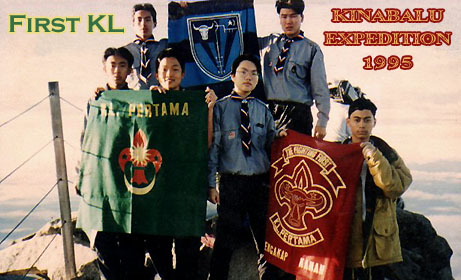
expenditure amounting to around RM1000 for the entire trip. Truly Low’s Peak has the attractiveness of being the highest peak in South-East Asia, but there are two major reasons that the V.I. Scouts never made it a frequent destination for their expeditions. Firstly, there is the cost hurdle, and secondly, it seems much less a test of machismo than Gunung Tahan. For instance, the entire Gunung Kinabalu expedition takes on average 2 nights, while to conquer Tahan via the Kuala Juram trail (as opposed to the Merapoh trail), it takes an average of 6 nights. Of course, this depends on how quickly the group moves, but one cannot deny that in order to even get near Tahan, the hiker must lumber at least 70 kilometres (with his cumbersome haversack!), while for Kinabalu, the hiker is driven halfway up the mountain.
Continuing this tradition of mountain-climbing expeditions, 11 Senior Scouts and one Scouter from Second KL scaled the treacherous Gunung Tahan again between 29 May and 6 June 1997. (See Tahan Expedition (1997).) Following close on the heels of the Second KL expedition was a Cycling Expedition to Singapore, organised by First KL. Nine members participated in this expedition which lasted from 25 November to 29 November 1997. They cycled from Port Dickson to Johor Bahru, covering a total distance of 250 gruelling kilometres. The next series of expeditions came in 1999. Second KL organised a Gunung Tahan expedition which lasted from 27 May to 1 June. By completing the quest in five days, the group of seven Seniors and one Scouter completed the fastest climb and descent of Tahan for V.I. Scouts, as far as historical records show. Earlier that year, five Form 4 seniors of Second KL succeeded in covering a distance of 240 kilometres during the KL (from Batu Caves) to Pekan Maran Walk which was held from 26 to 30 April.
As if unsatisfied with this double feat, Second KL
achieved a triple conquest during the millennium cusp year of 2000.
Two Scouters and four Seniors flew to Sabah to climb Gunung Kinabalu. The
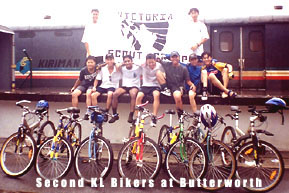 expedition lasted from 3 to 6 January. Just two months later, the nine
Form 4 Seniors of the group walked in their predecessors’ footsteps
when they joined the 240 kilometre KL to Pekan Maran Walk. At the end
of the year, in November, three Scouters and six Seniors made their
way from KL to Penang on bicycles. (See VSG KL-Penang Cycling Expedition 2000.)
Leaving KL early in the morning
of 16 November, the group arrived at the Butterworth Train Station at
4.00 p.m. on 18 November. The group was greatly assisted by a parent of
one of the expedition members, Mr Yam Tong Woo. Indeed, like the Second
KL Parents’ Committee in the 1950’s which played an advisory role in
the group’s activities, so, too, Mr Yam was pivotal in organising
logistics and helping in the planning of this event, even accompanying
the group by driving all the way to Penang.
expedition lasted from 3 to 6 January. Just two months later, the nine
Form 4 Seniors of the group walked in their predecessors’ footsteps
when they joined the 240 kilometre KL to Pekan Maran Walk. At the end
of the year, in November, three Scouters and six Seniors made their
way from KL to Penang on bicycles. (See VSG KL-Penang Cycling Expedition 2000.)
Leaving KL early in the morning
of 16 November, the group arrived at the Butterworth Train Station at
4.00 p.m. on 18 November. The group was greatly assisted by a parent of
one of the expedition members, Mr Yam Tong Woo. Indeed, like the Second
KL Parents’ Committee in the 1950’s which played an advisory role in
the group’s activities, so, too, Mr Yam was pivotal in organising
logistics and helping in the planning of this event, even accompanying
the group by driving all the way to Penang.
INTERACTION WITH OTHERS AND HIGH ACHIEVEMENTS
To achieve excellence, one should be able to compare oneself with others. Truly there has been no shortage of this amongst the V.I. Scouts, as they continued to participate in various jamborees and competitions in the 1990’s. January 1988 saw the Malaysian Open Orienteering Championships being held at the Rubber Research Institute, Sungai Buloh and the Forest Research Institute, Kepong. Senior Scout Tan Koon Peng of Second KL emerged eighth on the first day, and second on the second day, to win fifth placing overall. As for jamborees, after the 1987 World Jamboree, there was no jamboree participation for six years. 1993 saw the resurrection of such participations as has been highlighted in detail above. On the local scene, the First and Second KL Scouts took part in the Central Malaysian Jamboree-On-The-Air (9M2DS). Second KL emerged as runner-up of the overall competition. This took place at Kem Sardon Jubir, Balakong in October. On the international scene, two First KL Scouts attended the Thailand Jamboree which was held in November. They rejuvenated a trend of jamboree participations among the V.I. Scouts by virtue of their jamboree participation as they established close contact with several scout commissioners, including the Assistant District Commissioner of Batu district, Lionel Sia Wai Seng.

ADC Sia was later pivotal in assisting the Second KL Scouts in their aim to participate in an international jamboree. In 1995, this dream was realised when 11 members (two Scouters and nine Seniors) of Second KL were selected to represent Malaysia at the 15th Asia Pacific/ 17th Australian Jamboree at Perry Lakes in Perth, Australia. Loh Kok Kin was chosen as the national secretary to the jamboree while Chow Fui Foo was made the treasurer. The jamboree was a wholesome 11 days of frolic which included flights on a small plane, rifle-firing, raft-building and sightseeing. (See Jamboree in Australia - 1995.) At the end of the jamboree, they were bestowed with the "Alpha Centauri" jamboree award. Two years later, in 1997, the 16th Asia-Pacific Jamboree was held in Besut, Terengganu. This event saw the participation of the 14 Second KL Scouts. Unfortunately, this event was marred by tragedy, particularly for the members of the Kuala Lumpur contingent. The State Commissioner, Mr K.S. Maniam, passed away during the jamboree, and the V.I. Scouts as well as the other members of the state contingent, had to go into mourning for two days. It was a personal tragedy as well for one of the Second KL participants as SC Maniam was his uncle. Then from 2 to 6 September, 2000, there was a Mini Jamboree at the Laman Bistari Resort, Ulu Yam in which the V.I. Scouts participated. They were also awarded with the "Dato Bandar" jamboree award.
In 1998, after a wait of five years, there finally came another opportunity to prove the mettle of the V.I. Scouts in an inter-Troop competition. The State Education Department organised an Orienteering Competition at Bukit Kiara, open to Scouts and non-Scouts alike. Second KL was represented by its six PL’s, who emerged champions in the under-15 age category after defeating 60 other teams. Indeed, in the 1990’s, though the two groups continued their pursuit of their Pengakap Raja award in vain, the accomplishments of the V.I. Scouts such as winning this orienteering competition, put them shoulder to shoulder with those inducted with the award.
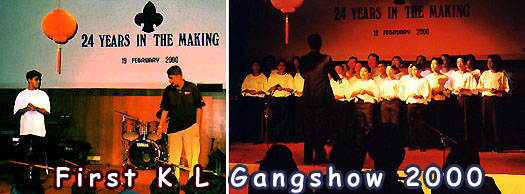
While the absence of the award does not signify weakness, producing Pengakap Raja has always been a goal of the V.I. Scouts. The barren run for the V.I. Troops for about two decades was to finally end in 2000 when a member of First KL was standardised as a Pengakap Raja that year. “Scouting begins not with the Tenderfoot or even Second Class Badge, but with the First Class Badge” is a saying attributed to Lord Baden-Powell. So, surely this accomplishment of Pengakap Raja status by Yogesh Anand from First KL would have thrilled the grand old man had he been alive in 2000. Indeed, this was a long overdue award, for surely the V.I. Scouts had proven themselves worthy of Pengakap Raja status with all the activities organised and victories won over the last decade. This award was a rubber stamp on the quality and standards of the V.I. Scouts.
GIVING AND RECEIVING
The V.I. Troops never forgot their duty to community, not just because of the third Scout law, but also because of the inherent value of giving service to others. Every year, the Scouts helped in traffic control during Speech Days, Sports Days and Band Tattoos. Other duties have included:
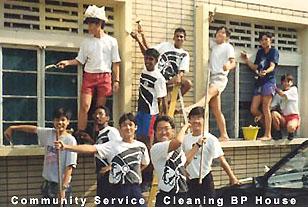 we see the proliferation of technologies like the Internet,
microprocessors and mobile phones which only in the early 1990’s, were
the preserve of a privileged few. Present day students have HTML
knowledge at their finger tips, and mobile phones in their school
bags. Tuition centres have mushroomed as demand for them has
inordinately soared over the last decade. The development of the LRT
and air-conditioned Intrakota buses have meant that students seldom or
no longer have to queue for buses that are sardine-packed with sweaty
and smelly bodies all around. And few find reason to eat at Nam Heong
Chicken Rice on Sultan Street when just a block away, there is Nando’s
Portuguese Chicken and Starbucks Coffee.
we see the proliferation of technologies like the Internet,
microprocessors and mobile phones which only in the early 1990’s, were
the preserve of a privileged few. Present day students have HTML
knowledge at their finger tips, and mobile phones in their school
bags. Tuition centres have mushroomed as demand for them has
inordinately soared over the last decade. The development of the LRT
and air-conditioned Intrakota buses have meant that students seldom or
no longer have to queue for buses that are sardine-packed with sweaty
and smelly bodies all around. And few find reason to eat at Nam Heong
Chicken Rice on Sultan Street when just a block away, there is Nando’s
Portuguese Chicken and Starbucks Coffee. 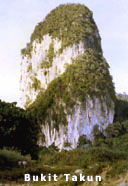
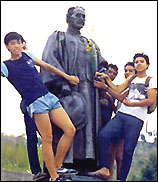 statue of the grand old philanthropist stares plaintively into space.
And with the rapid modernisation of the city, who knows what will happen
to the popular ‘Scout Shops’ and ‘Scout Products’? These are shops that
anyone can identify with; be he a Scout in 1998 or a scout from the 1980’s
or before. Any fresh Form 1 member would be able to point out to you the
shops along Jalan Tun Perak (formerly Java Street, and later Mountbatten
Road) where their PL would take them to buy camping equipment like hemp
ropes (or more popularly called lashing ropes) and gunnysacks. Then
there are the shops along Petaling Street, peddling cooking accessories
like woks and pans; particularly popular amongst patrols who always
misplaced their equipment bought for the last camp. And of course, the
shop on Jalan Kenanga, opposite the V.I., which was a favourite haunt
for quartermasters needing to stock up on pressure lamp mantles (the
‘Butterfly’ brand being the most reliable), spare parts and kerosene.
statue of the grand old philanthropist stares plaintively into space.
And with the rapid modernisation of the city, who knows what will happen
to the popular ‘Scout Shops’ and ‘Scout Products’? These are shops that
anyone can identify with; be he a Scout in 1998 or a scout from the 1980’s
or before. Any fresh Form 1 member would be able to point out to you the
shops along Jalan Tun Perak (formerly Java Street, and later Mountbatten
Road) where their PL would take them to buy camping equipment like hemp
ropes (or more popularly called lashing ropes) and gunnysacks. Then
there are the shops along Petaling Street, peddling cooking accessories
like woks and pans; particularly popular amongst patrols who always
misplaced their equipment bought for the last camp. And of course, the
shop on Jalan Kenanga, opposite the V.I., which was a favourite haunt
for quartermasters needing to stock up on pressure lamp mantles (the
‘Butterfly’ brand being the most reliable), spare parts and kerosene.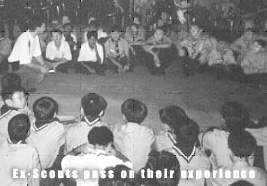 maturity and wisdom that help the Scouts distinguish between what is
faddish and what is universal, what is temporarily in fashion and what
is permanent and constant. It is the recognition of certain undying
universal values such as maturity, adventurousness, moral integrity,
perseverance and an unending pursuit of wisdom, that have allowed the
V.I. Scouts to withstand threats to their excellence. Of course,
Troops from other schools could identify with these virtues as well,
but the V.I. Scout movement has an advantage over many Troops - its
age. By keeping in contact with Ex’s and constantly seeking their
advice; by preserving old documents, photos and log books and
constantly studying them; by maintaining old activities while
constantly seeking out new ones - these are the means by which the
V.I. Scouts have defended their status over the last 90 years. When
one looks into the past, one can find shortcuts, wisdom and ultimately
inspiration because he sees what mistakes his predecessors have
committed and what techniques they had used to accomplish great feats.
To break this link with one’s elders and one’s past is to waste one’s
potential for glory and excellence.
maturity and wisdom that help the Scouts distinguish between what is
faddish and what is universal, what is temporarily in fashion and what
is permanent and constant. It is the recognition of certain undying
universal values such as maturity, adventurousness, moral integrity,
perseverance and an unending pursuit of wisdom, that have allowed the
V.I. Scouts to withstand threats to their excellence. Of course,
Troops from other schools could identify with these virtues as well,
but the V.I. Scout movement has an advantage over many Troops - its
age. By keeping in contact with Ex’s and constantly seeking their
advice; by preserving old documents, photos and log books and
constantly studying them; by maintaining old activities while
constantly seeking out new ones - these are the means by which the
V.I. Scouts have defended their status over the last 90 years. When
one looks into the past, one can find shortcuts, wisdom and ultimately
inspiration because he sees what mistakes his predecessors have
committed and what techniques they had used to accomplish great feats.
To break this link with one’s elders and one’s past is to waste one’s
potential for glory and excellence. 
